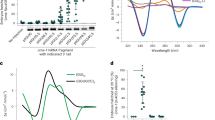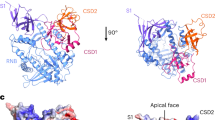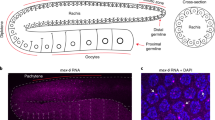Abstract
RNA interference (RNAi) regulates gene expression by the cleavage of messenger RNA, by mRNA degradation and by preventing protein synthesis. These effects are mediated by a ribonucleoprotein complex known as RISC (RNA-induced silencing complex)1. We have previously identified four Drosophila components (short interfering RNAs1, Argonaute 2 (ref. 2), VIG and FXR3) of a RISC enzyme that degrades specific mRNAs in response to a double-stranded-RNA trigger. Here we show that Tudor-SN (tudor staphylococcal nuclease)—a protein containing five staphylococcal/micrococcal nuclease domains and a tudor domain—is a component of the RISC enzyme in Caenorhabditis elegans, Drosophila and mammals. Although Tudor-SN contains non-canonical active-site sequences, we show that purified Tudor-SN exhibits nuclease activity similar to that of other staphylococcal nucleases. Notably, both purified Tudor-SN and RISC are inhibited by a specific competitive inhibitor of micrococcal nuclease. Tudor-SN is the first RISC subunit to be identified that contains a recognizable nuclease domain, and could therefore contribute to the RNA degradation observed in RNAi.
This is a preview of subscription content, access via your institution
Access options
Subscribe to this journal
Receive 51 print issues and online access
$199.00 per year
only $3.90 per issue
Buy this article
- Purchase on Springer Link
- Instant access to full article PDF
Prices may be subject to local taxes which are calculated during checkout




Similar content being viewed by others
References
Hammond, S. M., Bernstein, E., Beach, D. & Hannon, G. J. An RNA-directed nuclease mediates post-transcriptional gene silencing in Drosophila cells. Nature 404, 293–296 (2000)
Hammond, S. M., Boettcher, S., Caudy, A. A., Kobayashi, R. & Hannon, G. J. Argonaute2, a link between genetic and biochemical analyses of RNAi. Science 293, 1146–1150 (2001)
Caudy, A. A., Myers, M., Hannon, G. J. & Hammond, S. M. Fragile X-related protein and VIG associate with the RNA interference machinery. Genes Dev. 16, 2491–2496 (2002)
Hannon, G. J. RNA interference. Nature 418, 244–251 (2002)
Hamilton, A. J. & Baulcombe, D. C. A species of small antisense RNA in posttranscriptional gene silencing in plants. Science 286, 950–952 (1999)
Elbashir, S. M., Martinez, J., Patkaniowska, A., Lendeckel, W. & Tuschl, T. Functional anatomy of siRNAs for mediating efficient RNAi in Drosophila melanogaster embryo lysate. EMBO J. 20, 6877–6888 (2001)
Bernstein, E., Caudy, A. A., Hammond, S. M. & Hannon, G. J. Role for a bidentate ribonuclease in the initiation step of RNA interference. Nature 409, 363–366 (2001)
Maurer-Stroh, S. et al. The Tudor domain ‘Royal Family’: Tudor, plant Agenet, Chromo, PWWP and MBT domains. Trends Biochem. Sci. 28, 69–74 (2003)
Ponting, C. P. P100, a transcriptional coactivator, is a human homologue of staphylococcal nuclease. Protein Sci. 6, 459–463 (1997)
Callebaut, I. & Mornon, J. P. The human EBNA-2 coactivator p100: Multidomain organization and relationship to the staphylococcal nuclease fold and to the tudor protein involved in Drosophila melanogaster development. Biochem. J. 321, 125–132 (1997)
Tong, X., Drapkin, R., Yalamanchili, R., Mosialos, G. & Kieff, E. The Epstein–Barr virus nuclear protein 2 acidic domain forms a complex with a novel cellular coactivator that can interact with TFIIE. Mol. Cell. Biol. 15, 4735–4744 (1995)
Carmell, M. A., Xuan, Z., Zhang, M. Q. & Hannon, G. J. The Argonaute family: Tentacles that reach into RNAi, developmental control, stem cell maintenance, and tumorigenesis. Genes Dev. 16, 2733–2742 (2002)
Hutvagner, G. & Zamore, P. D. A microRNA in a multiple-turnover RNAi enzyme complex. Science 297, 2056–2060 (2002)
Mourelatos, Z. et al. miRNPs: A novel class of ribonucleoproteins containing numerous microRNAs. Genes Dev. 16, 720–728 (2002)
Martinez, J., Patkaniowska, A., Urlaub, H., Luhrmann, R. & Tuschl, T. Single-stranded antisense siRNAs guide target RNA cleavage in RNAi. Cell 110, 563–574 (2002)
Keenan, T. W., Winter, S., Rackwitz, H. R. & Heid, H. W. Nuclear coactivator protein p100 is present in endoplasmic reticulum and lipid droplets of milk secreting cells. Biochim. Biophys. Acta 1523, 84–90 (2000)
Serpersu, E. H., Shortle, D. & Mildvan, A. S. Kinetic and magnetic resonance studies of active-site mutants of staphylococcal nuclease: Factors contributing to catalysis. Biochemistry 26, 1289–1300 (1987)
Cuatrecasas, P., Fuchs, S. & Anfinsen, C. B. The binding of nucleotides and calcium to the extracellular nuclease of Staphylococcus aureus. Studies by gel filtration. J. Biol. Chem. 242, 3063–3067 (1967)
Slack, F. J. et al. The lin-41 RBCC gene acts in the C. elegans heterochronic pathway between the let-7 regulatory RNA and the LIN-29 transcription factor. Mol. Cell 5, 659–669 (2000)
Grishok, A. et al. Genes and mechanisms related to RNA interference regulate expression of the small temporal RNAs that control C. elegans developmental timing. Cell 106, 23–34 (2001)
Ketting, R. F. et al. Dicer functions in RNA interference and in synthesis of small RNA involved in developmental timing in C. elegans. Genes Dev. 15, 2654–2659 (2001)
Knight, S. W. & Bass, B. L. A role for the RNase III enzyme DCR-1 in RNA interference and germ line development in Caenorhabditis elegans. Science 293, 2269–2271 (2001)
Reinhart, B. J. et al. The 21-nucleotide let-7 RNA regulates developmental timing in Caenorhabditis elegans. Nature 403, 901–906 (2000)
Llave, C., Xie, Z., Kasschau, K. D. & Carrington, J. C. Cleavage of Scarecrow-like mRNA targets directed by a class of Arabidopsis miRNA. Science 297, 2053–2056 (2002)
Tang, G., Reinhart, B. J., Bartel, D. P. & Zamore, P. D. A biochemical framework for RNA silencing in plants. Genes Dev. 17, 49–63 (2003)
Spankuch-Schmitt, B., Bereiter-Hahn, J., Kaufmann, M. & Strebhardt, K. Effect of RNA silencing of polo-like kinase-1 (PLK1) on apoptosis and spindle formation in human cancer cells. J. Natl Cancer Inst. 94, 1863–1877 (2002)
Capodici, J., Kariko, K. & Weissman, D. Inhibition of HIV-1 infection by small interfering RNA-mediated RNA interference. J. Immunol. 169, 5196–5201 (2002)
Hirayoshi, K. & Lis, J. T. Nuclear run-on assays: assessing transcription by measuring density of engaged RNA polymerases. Methods Enzymol. 304, 351–362 (1999)
Avalos, R. T., Yu, Z. & Nayak, D. P. Association of influenza virus NP and M1 proteins with cellular cytoskeletal elements in influenza virus-infected cells. J. Virol. 71, 2947–2958 (1997)
Spector, D. L. & Smith, H. C. Redistribution of U-snRNPs during mitosis. Exp. Cell Res. 163, 87–94 (1986)
Acknowledgements
We thank A. Mildvan, M. Tijsterman and T. Sijen for discussions. We thank T. Keenan for an anti-p100 antibody, T. Hobman for GERP (EIF2C2/hAgo2) antibody, H. Siomi for a FXR monoclonal antibody, and F. Slack for the lacZ–lin-41 reporter. A.A.C. is a George A. and Marjorie H. Anderson Fellow of the Watson School of Biological Sciences, and a Howard Hughes Medical Institute Predoctoral Fellow. A.M.D. is a David Koch Fellow of the Watson School of Biological Sciences. J.M.S. is supported by a postdoctoral fellowship from the US Army Prostate Cancer Research programme. G.J.H. is a Rita Allen Foundation Scholar and is supported by an Innovator Award from the US Army Breast Cancer Research programme. This work was also supported by a grant from the National Institutes of Health (G.J.H.) and by a VENI fellowship from the Netherlands Organization for Scientific Research (RFK).
Author information
Authors and Affiliations
Corresponding authors
Ethics declarations
Competing interests
The authors declare that they have no competing financial interests.
Supplementary information
Rights and permissions
About this article
Cite this article
Caudy, A., Ketting, R., Hammond, S. et al. A micrococcal nuclease homologue in RNAi effector complexes. Nature 425, 411–414 (2003). https://doi.org/10.1038/nature01956
Received:
Accepted:
Issue Date:
DOI: https://doi.org/10.1038/nature01956
This article is cited by
-
The important role of miR-1-3p in cancers
Journal of Translational Medicine (2023)
-
SND1 binds to ERG and promotes tumor growth in genetic mouse models of prostate cancer
Nature Communications (2023)
-
A genome-wide screening for RNAi pathway proteins in Acari
BMC Genomics (2020)
-
Modified base-binding EVE and DCD domains: striking diversity of genomic contexts in prokaryotes and predicted involvement in a variety of cellular processes
BMC Biology (2020)
-
Gene silencing by RNA interference in the ectoparasitic mite, Psoroptes ovis
Veterinary Research (2018)
Comments
By submitting a comment you agree to abide by our Terms and Community Guidelines. If you find something abusive or that does not comply with our terms or guidelines please flag it as inappropriate.



